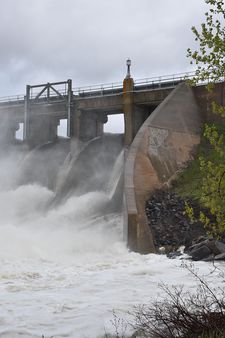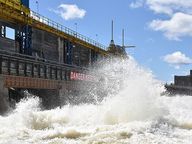Levels on the Winnipeg River are at historic levels – and that is with no quotes around the word historic – as our recorded history does not show this much water since levels on the river were first recorded, back in the beginning of the 1900s.
The good news, our generating stations on the Winnipeg River were built to allow the amounts of water we are seeing this spring to pass downriver.
Dealing With Historic Winnipeg River Levels — June 2022
Manitoba hasn’t seen water levels on the Winnipeg River this high in our recorded history. Watch how we’re dealing with these historic levels.
While there are currently no worries about our dams not being able to deal with the levels on the Winnipeg River, there is still a lot of work being done to react to and manage this unique event.

The spillway gates at Seven Sisters Generating Station passing the floodwaters
There is a large team effort looking after such a historic event. From full-time forecasters who help the team for the Winnipeg River prepare for expected water flows, to monitoring & inspection teams who keep track of our facilities and structures, to the operators who adjust and maintain the individual stations’ ability to pass water through our system.
Even though the whole team is focussed on their part in contributing to working through a bit of Manitoba Hydro history, as many of them live in the area, they do remind us all that those who live along the river system are dealing with this unprecedented event on a personal level.
Myth: ‘all this water means we’re generating a lot of electricity’
There are several reasons people may misinterpret what all this water going down the Winnipeg River system means for generating electricity.
Firstly, the impressive rush of water you see is not in any way contributing to generating power. While it looks impressive, it is really water that is being diverted around our generating stations by what is called a “spillway”.
The dams and the structures of our generating stations are intended to maintain a certain depth of water in the forebay (the upstream side) that is also referred to as the “head” (more on that later).
If the water system is sending too much water towards a station, then — to maintain a proper level in that forebay — we open up gates in the spillway, off to the side of the generating station, to allow that water around that station.
But this water just streams past the station and does not get a chance to go through a generating unit, so it never makes any electricity.
It looks impressive, but people in generation see it as wasted water that we have to allow past our stations without generating any power.
Secondly, higher river levels actually make it harder to generate electricity with the water that does go through the generating units.
From physics class, an object that is held high up in the air has potential energy; when it is dropped that converts into actual energy, and if you have a way to process that change in height you can capture energy for your use.
The head of the forebay at a generating station is a way to manage the potential energy in water coming down a river. You want to have a certain head on the upstream side, then you want to convert that potential that’s stored in the height of the water.
This is done by letting it “fall” through a generating station to the “tailrace” side – the area immediately downstream of the building. The further it has to fall during this transition, the more of that formerly stored energy gets converted into electricity.
But that is where the higher river levels actually work against us.
We maintain a fairly consistent level in the forebay (see above where we talk about using the spillway to “spill” excess water from upstream), so increased river levels effect the height in the tailrace more.
So, if the level in the tailrace is higher, then the water in the Winnipeg River system (compared to averages) has less distance to fall as it passes through our generating units. That means it lacks the opportunity to give up more of its stored energy as we try and convert it to electricity, and the less we can generate off of it.
(If you ever played with a Slinky and a set of stairs, think of it like normally getting to play on a staircase, but now you have to play on just a few steps. Much less fun is generated.)




